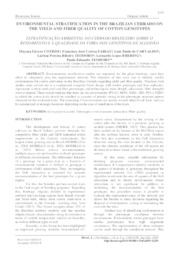Environmental stratification in the brazilian Cerrado on the yield and fiber quality of cotton genotypes.
Environmental stratification in the brazilian Cerrado on the yield and fiber quality of cotton genotypes.
Author(s): COTRIM, M. F.; FARIAS, F. J. C.; CARVALHO, L. P. de; TEODORO, L. P. R.; BHERING, L. L.; TEODORO, P. E.
Summary: Environmental stratification studies are important for the plant breeding, since they allow to adequately plan the experimental network. The objective of this work was to identify similar environments for cotton cultivation in the Brazilian Cerrado regarding yield and fiber quality. Nineteen field studies were carried out in a randomized complete block design with twelve genotypes and four replicates. Agronomic (cotton seed yield and fiber percentage) and technological traits (length, micronaire, fiber strength) were evaluated. These results indicate that there are six environments (PVA3, MON, SHE1, SIN, PPA e TRIN) in which the cotton trials should be installed as a matter of priority owing to the phenotypic response pattern obtained for the evaluated traits. The remaining 13 environments are similar to each other for all traits and can be summarized in strategic locations depending on the ease of installation of the trials.
Publication year: 2019
Types of publication: Journal article
Unit: Embrapa Cotton
Observation
Some of Embrapa's publications are published as ePub files. To read them, use or download one of the following free software options to your computer or mobile device. Android: Google Play Books; IOS: iBooks; Windows and Linux: Calibre.
Access other publications
Access the Agricultural Research Database (BDPA) to consult Embrapa's full library collection and records.
Visit Embrapa Bookstore to purchase books and other publications sold by Embrapa.

